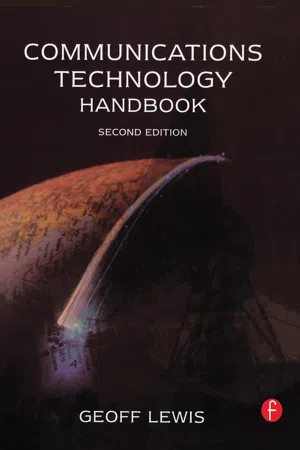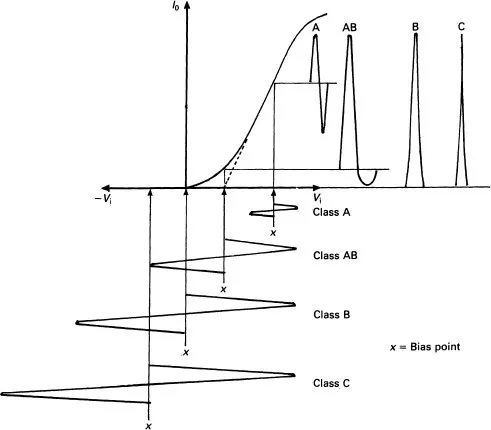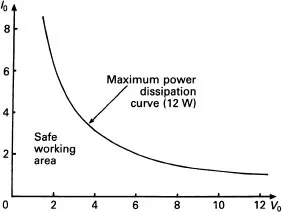![]()
1 Analogue systems and concepts
Analogue systems are characterised by electrical signals that vary continuously between two extreme amplitude levels. There is thus an infinity of actual levels that such signals can assume. Compared with other forms, analogue signals usually occupy minimum bandwidth.
1.1 Amplifiers
Amplifiers can be sub-divided into many different types, each designed for some specific purpose. But depending upon the time period for which the output current flows with respect to a changing input signal, they can be assigned to one of the classifications shown in Fig 1.1.
Figure 1.1 Amplifier classification by transfer characteristic.
Class A
The output current flows for the whole or 360° of the input sinusoidal signal. The amplifier is biased to the mid-point of the straight part of its characteristic as shown, to ensure the minimum of distortion. As a large signal or power amplifier, the efficiency as measured by the ratio:
(ac signal power output/dc power input) x 100%
is theoretically 50%. In a practical case however, an efficiency in excess of 35% is rarely achieved. Because of the high degree of linearity, these amplifiers are commonly used for audio or low frequency applications.
Class B
The output current flows for only 180°, or half of the sinusoidal input signal. The amplifier being biased to cut-off causes such distortion that it effectively acts as a half-wave rectifier. The theoretical efficiency is 78.5% (π/4 x 100%), and in practice this rarely exceeds 65%. In low frequency and audio applications, Class B is used in push-pull, using two stages, one for the amplification of each half cycle. Even so, it is often necessary to take care to minimise the effect of cross-over distortion. For radio frequency applications, this class can be used with a tuned circuit load, where the natural flywheel action replaces the missing half cycle.
Class AB
The output current flows for more than 180° of the input cycle as the amplifier is biased to the projected cut-off point. This is defined as the bias point at which the amplifier current would fall to zero if the characteristic had been linear. The theoretical efficiency is somewhat less than that for Class B, but when used in a push-pull circuit, the cross-over distortion is reduced. The class is very commonly used for audio power amplification or as a radio frequency amplifier with a tuned circuit load.
Class C
These amplifiers are biased beyond the cut-off point so that output current flows for much less than 180° of the input cycle. The typical angle of flow, which is defined by the ratio:
is less than 120°. Theoretically the efficiency approaches 100% as the angle of flow approaches zero. In practice, this value can be as high as 90%. Because of the severe distortion that Class C operation generates, this class can only be used with a tuned circuit load, i.e., as a radio frequency amplifier, or as a harmonic generator, with the tuned circuit extracting the required harmonic frequency from the distortion components.
Class D
For audio and low frequency applications, the requirements of low distortion and high power output produce a conflict. The low efficiency of Class A is due to the excessive power dissipation in the output stages. Operation has to remain within the safe working area to protect the amplifier from thermal damage (see Fig. 1.2).
Figure 1.2 Maximum power dissipation curve.
If the amplifier can be operated in either the saturated or cut-off state, then the power dissipation will be low, because either the voltage across the active device or the current through it will be very low. Further, if the amplifier can be switched rapidly between these states, the power dissipation during the transition through the active region will also be very low. The output power is controlled by varying the time spent in these two extreme states, this depending upon the instantaneous amplitude of the signal to be amplified. Thus Class D operation is a form of pulse width or duration modulation, which can achieve a practical efficiency as high as 97%.
Typically the switching frequency exceeds 50 kHz, but significantly higher values may be used. This has the advantages of smaller filters to remove the switching frequency from the output, lower radiation of unwanted interference, reduced intermodulation distortion and a wider bandwidth.
Class E
When a switching mode is used for RF power amplifiers and the transition periods between the On and Off states become an appreciable part of the period of the signal being processed, a significant power loss arises. Class E overcomes this problem by including LC filters between the switcher and the load to delay the current transition relative to the voltage swing. This ensures that either the voltage or the current is simultaneously zero during the switching period.
Theoretically the efficiency for Class E can be 100% with practical values in excess of 90% at VHF frequencies being achieved.
Class E is equally applicable to thermionic or semiconductor RF power devices and has a low sensitivity to component tolerances
Current dumping amplifiers
This system was devised to provide audio frequency power amplification with very low distortion. Operation is based on the premise that a system that provides a distortionless no load voltage and an output impedance that is independent of the load, must be distortionless. The basic circuit is shown in Fig. 1.3, where A1 is a small Class A amplifier that is capable of providing the total output voltage swing, but with a very limited current capability. The emitter follower transistors Tr1, and Tr2 are designed to dump current into the load under the control of A1. In this way, the two sections combine to provide the total output power. The very low level of distortion is achieved by the use of the feedback networks. Capacitor C1 ensures that the integrator circuit which has a response that extends to well beyond the maximum operating frequency, provides a gain that falls with rising frequency. R2 provides a feedback voltage that depends upon the impedance of L1 and thus has an opposite effect to that produced by C1. A further feedback path provided by R3 operates over the dumper stages.
1.2 Distortions (see also under Measurements, p. 159)
The information carried by an analogue signal is contained within the signal’s instantaneous amplitude, frequency and phase. Any phenomenon that disturbs this relationship, distorts the waveform and reduces the intelligibility of the signal. Since this is an unwanted feature of the signal processing, distortion has a noiselike effect. This effect can be quantified either by measurement or analysis and can be expressed as a kind of signal to noise ratio, usually in the form:
Amplitude or non-linear distortion
In a practical amplifier, the dynamic transfer characteristic is always to some extent non-linear. That is, equal incremental inputs do not produce equal incremental outputs. This is particularly noticeable in large signal power amplifiers, where a saturation condition arises. A useful measure of a system’s performance in this respect is shown by the 1 dB compression point as indicated in Fig. 1.4. This point represents the output power level where the signal is 1 dB below the value that would obtain if the system were linear. In the case shown, 1 dB compression occurs ...




